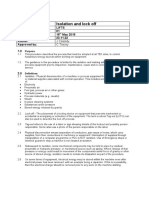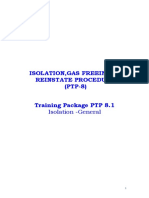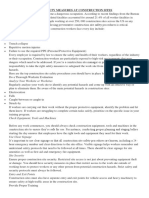0 ratings0% found this document useful (0 votes)
50 viewsScope: Types of Hazardous Energy & Its Potential: This Standard
Scope: Types of Hazardous Energy & Its Potential: This Standard
Uploaded by
ananthu.uThis document outlines Vedanta's safety performance standard for isolation. It defines isolation as the process of securing energy sources to ensure safety before performing work. The standard applies across Vedanta's operations and requires nine mandatory isolation steps be followed, including designating an Isolation Officer, de-energizing equipment, securing isolation devices with locks and tags, verifying zero energy state, performing the task, and restoring normal operations. The Isolation Officer is responsible for executing the isolation procedure safely and their lock must be applied first and removed last to ensure safety. Everyone working on isolated equipment must apply their own lock.
Copyright:
© All Rights Reserved
Available Formats
Download as PDF, TXT or read online from Scribd
Scope: Types of Hazardous Energy & Its Potential: This Standard
Scope: Types of Hazardous Energy & Its Potential: This Standard
Uploaded by
ananthu.u0 ratings0% found this document useful (0 votes)
50 views1 pageThis document outlines Vedanta's safety performance standard for isolation. It defines isolation as the process of securing energy sources to ensure safety before performing work. The standard applies across Vedanta's operations and requires nine mandatory isolation steps be followed, including designating an Isolation Officer, de-energizing equipment, securing isolation devices with locks and tags, verifying zero energy state, performing the task, and restoring normal operations. The Isolation Officer is responsible for executing the isolation procedure safely and their lock must be applied first and removed last to ensure safety. Everyone working on isolated equipment must apply their own lock.
Original Description:
56 jj
Original Title
Isolation Standard
Copyright
© © All Rights Reserved
Available Formats
PDF, TXT or read online from Scribd
Share this document
Did you find this document useful?
Is this content inappropriate?
This document outlines Vedanta's safety performance standard for isolation. It defines isolation as the process of securing energy sources to ensure safety before performing work. The standard applies across Vedanta's operations and requires nine mandatory isolation steps be followed, including designating an Isolation Officer, de-energizing equipment, securing isolation devices with locks and tags, verifying zero energy state, performing the task, and restoring normal operations. The Isolation Officer is responsible for executing the isolation procedure safely and their lock must be applied first and removed last to ensure safety. Everyone working on isolated equipment must apply their own lock.
Copyright:
© All Rights Reserved
Available Formats
Download as PDF, TXT or read online from Scribd
Download as pdf or txt
0 ratings0% found this document useful (0 votes)
50 views1 pageScope: Types of Hazardous Energy & Its Potential: This Standard
Scope: Types of Hazardous Energy & Its Potential: This Standard
Uploaded by
ananthu.uThis document outlines Vedanta's safety performance standard for isolation. It defines isolation as the process of securing energy sources to ensure safety before performing work. The standard applies across Vedanta's operations and requires nine mandatory isolation steps be followed, including designating an Isolation Officer, de-energizing equipment, securing isolation devices with locks and tags, verifying zero energy state, performing the task, and restoring normal operations. The Isolation Officer is responsible for executing the isolation procedure safely and their lock must be applied first and removed last to ensure safety. Everyone working on isolated equipment must apply their own lock.
Copyright:
© All Rights Reserved
Available Formats
Download as PDF, TXT or read online from Scribd
Download as pdf or txt
You are on page 1of 1
SAFETY PERFORMANCE STANDARD
ISOLATION 2.3. Everyone's responsibility
2.3.1. Everyone, including the Isolation Officer, who has to
1. Scope perform work on the plant, equipment or system,
This standard applies to all Vedanta business units and managed must first apply a personal lock and identification tag
operations, including new acquisitions, admin/corporate offices in accordance with the isolation procedure;
and research facilities located off site; during exploration, 2.3.2. Personal locks must be such that they can only be
through all development phases and construction, operation to locked/unlocked by their owner;
closure and, where applicable, for post closure management. 2.3.3. Personal locks may never be removed other than by
Types of Hazardous energy & its potential: This standard the person to whom they belong. Where a lock has
applies to all sources of hazardous energy and hazardous been inadvertently left in place and the department
substances. or area manager determines that it is impractical to
recall the owner, the lock can be removed but only
Energy Types under the direct supervision of the department or
Energy Kinetic Energy Potential Energy Examples area manager or his/her appointed nominee and in
Source Examples accordance with a written procedure.
Electrical Current Batteries, capacitors, voltage,
3. Process
Mechanical Turning shafts, gears Tensed spring, flywheel
3.1. There are nine mandatory isolation steps required for safe
Hydraulic Pistons, motors Pressure in accumulators
execution of jobs involving any type of energy isolation:
Pneumatic Actuators pistons Pressure in tanks, lines 3.1.1. Prepare for isolation by obtaining a written isolation
Steam Flowing steam Steam in pipelines, drums procedure identifying energy sources; the number of
Chemical Flowing liquid, gases, Trapped gases, liquid, slurry locks required; isolation devices; communication with
slurry, cake operators & other concerned persons;
Gravity Moving components Elevated counter weights 3.1.2. De-energize the plant or machine;
Radiation Released energy Contained source material 3.1.3. Isolate all energy sources;
3.1.4. Drain or block and, where appropriate, bleed residual
2. People energy to achieve a zero energy state;
2.1. Isolation Officer: Whenever equipment, plant or section of 3.1.5. Secure each isolation device, generally with locks &
plant is to be isolated there must be a person designated suitable tags;
to carry out the isolation procedure. That person is 3.1.6. Verify zero energy;
referred to as the Isolation Officer. No person may be 3.1.7. Perform the task or activity;
designated as the Isolation Officer for a piece of 3.1.8. Inspect & restore normalcy - inspect the work area
equipment unless s/he has been trained, assessed and and remove isolation after job completion;
authorized by the respective business unit as competent to 3.1.9. Startup - ensure the safety of all.
carry out the isolation procedure for that piece of plant or 3.2. Where it is necessary to work on live equipment for the
equipment. Tests for voltage, for example, require purposes of commissioning, testing, sampling and
competency in electrical work as outlined in the electrical adjustments, such work shall be carried out in accordance
standard. with a written procedure;
2.2. Isolation Officer's responsibility 3.3. Where there is a need for work to extend over multiple
2.2.1. Ensure safe start/stop & execution in accordance shifts or where there are large numbers of people involved
with the isolation procedure before any work begins; in the work, such as large maintenance & shutdown jobs
2.2.2. The Isolation Officer’s lock and tag must be the first or projects, a project isolation procedure can be
to be applied and the last to be removed; implemented. This procedure must include requirements
2.2.3. The Isolation Officer’s lock must be a master series that 1) personal locks shall be used for each person
lock since it will remain on the plant or equipment working on the project; 2) an Isolation Officer’s control
when handing over to subsequent shifts and to lock is in place; and 3) the control lock cannot be unlocked
another designated Isolation Officer; without all personal locks first being removed.
2.2.4. Where isolation involves only one person on jobs to
4. Review
be completed within a single shift and where it is not
4.1. For further details on isolation refer to the Vedanta
appropriate for a master series lock to be utilized, the
Guidance notes and the respective business unit isolation
person must be an Isolation Officer and s/he must
manual and procedures;
apply his/her personal lock and identification tag;
4.2. Business units are required to comply with all relevant
2.2.5. After locking and tagging, the Isolation Officer must
local laws and regulations on isolation standards along
clear the area of personnel before a trial step to
with Vedanta Isolation Standard.
ensure that the plant or equipment has been
isolated, achieved zero energy state & verified;
2.2.6. An Isolation Officer shall confirm effectiveness of
controls associated with the live work area; including Phil Turner
controls to prevent unauthorized access. Group Head Safety & Occupational Health
You might also like
- ISO 14001 2015 Audit Checklist. DQSDocument19 pagesISO 14001 2015 Audit Checklist. DQSananthu.u100% (6)
- Smoke Alarm Maintenance ChecklistDocument2 pagesSmoke Alarm Maintenance Checklistananthu.u100% (3)
- Safe Work Procedure - LOTO (Sample)Document3 pagesSafe Work Procedure - LOTO (Sample)cta2100% (2)
- Mattli - The Logic of Regional IntegrationDocument60 pagesMattli - The Logic of Regional IntegrationMihaela IojaNo ratings yet
- Content:: Saudi Arabian Oil Company (Saudi Aramco) General Instruction ManualDocument4 pagesContent:: Saudi Arabian Oil Company (Saudi Aramco) General Instruction Manualjhoni100% (1)
- Tata Projects Limited: Hazard Identification and Risk Assessment (HIRA)Document7 pagesTata Projects Limited: Hazard Identification and Risk Assessment (HIRA)ananthu.u100% (4)
- Jeffrey Gibble TBI ReportDocument9 pagesJeffrey Gibble TBI ReportAnonymous iBvi6lqXeUNo ratings yet
- Paul Maravelias's Pro Se NH Supreme Court Appeal Brief in 2018-0376, Paul Maravelias v. David DePamphilisDocument90 pagesPaul Maravelias's Pro Se NH Supreme Court Appeal Brief in 2018-0376, Paul Maravelias v. David DePamphilisPaul MaraveliasNo ratings yet
- Safety StandardDocument12 pagesSafety StandardGAURAHARI PATRANo ratings yet
- 01 Ecm Loto ProcedureDocument8 pages01 Ecm Loto ProcedureasifmfmmNo ratings yet
- HSSE126OP - Safe Process Isolation ProcedureDocument10 pagesHSSE126OP - Safe Process Isolation ProcedureUsman SuhaimyNo ratings yet
- 2.2 Lock Out, Tag Out and Try OutDocument11 pages2.2 Lock Out, Tag Out and Try OutSuad BushiNo ratings yet
- E30-E01-02 - 1 Elect Lockout-Tagout RequirementDocument5 pagesE30-E01-02 - 1 Elect Lockout-Tagout RequirementMuhammad IrfanNo ratings yet
- Procedure - ISOLATION AND LOCKOUTDocument8 pagesProcedure - ISOLATION AND LOCKOUTClyde K. LesoleNo ratings yet
- This Document Contains The Installation, Operation & Maintenance Instructions For Fortress Systems Neutral Earthing Resistors.Document12 pagesThis Document Contains The Installation, Operation & Maintenance Instructions For Fortress Systems Neutral Earthing Resistors.Dony RamdhaniNo ratings yet
- Isolation and Lock OffDocument5 pagesIsolation and Lock OffchrisNo ratings yet
- Energy Isolation LSRstandardDocument6 pagesEnergy Isolation LSRstandardesteves.kamiladiasNo ratings yet
- ISG-HSEOP-06-LOTO (Lockout Tag Out Procedure)Document8 pagesISG-HSEOP-06-LOTO (Lockout Tag Out Procedure)Julio GregorioNo ratings yet
- Rules For Life DescriptionDocument8 pagesRules For Life DescriptionالGINIRAL FREE FIRENo ratings yet
- NR 12 - Lockout and TaggingDocument5 pagesNR 12 - Lockout and TaggingCPSSTNo ratings yet
- Proposed LOTO Program BookDocument13 pagesProposed LOTO Program Booke050671aNo ratings yet
- Lockout Tagout ProcedureDocument12 pagesLockout Tagout ProcedureMugia WiprasetyaNo ratings yet
- AV-SWP-29 Electrical Isolation Iss 1Document4 pagesAV-SWP-29 Electrical Isolation Iss 1Kevin DeLimaNo ratings yet
- 05EnergyIsolation IOGP577version1.2Document2 pages05EnergyIsolation IOGP577version1.2ISQNo ratings yet
- Daikin Refrigeration Malaysia AHU IOMDocument26 pagesDaikin Refrigeration Malaysia AHU IOMAmmisadday AlvarezNo ratings yet
- Jet Pulse Fabric Filter - Safety ManualDocument25 pagesJet Pulse Fabric Filter - Safety ManualAmjed100% (2)
- OHS-PR-02 - 12 Control of Hazardous Work EnergyDocument19 pagesOHS-PR-02 - 12 Control of Hazardous Work Energyasiflalhaira0No ratings yet
- Mechanical Safe Working ProcedureDocument37 pagesMechanical Safe Working ProcedurenatarajanselvarasuNo ratings yet
- Dismantling Old MCC and Mounting New MCC - CELIN - Black Sea - Irak - 08-03-2018Document8 pagesDismantling Old MCC and Mounting New MCC - CELIN - Black Sea - Irak - 08-03-2018AlinaIordacheNo ratings yet
- Lock Out Tag Out GuidelineDocument7 pagesLock Out Tag Out Guideline이창선No ratings yet
- BA Maxicat-GB Juni 2015 PDFDocument14 pagesBA Maxicat-GB Juni 2015 PDFKheiro BelhadiaNo ratings yet
- Part I - 05 Isolation, Lockout and Use of Hold TagsDocument7 pagesPart I - 05 Isolation, Lockout and Use of Hold TagsMuhammad RizwanNo ratings yet
- E 24 25 GP 001 Isolation, Lockout and Permit To Work On Any Hazardous SystemDocument13 pagesE 24 25 GP 001 Isolation, Lockout and Permit To Work On Any Hazardous SystemJohn KalvinNo ratings yet
- Lock Out Tag Out Procedure 01 FSFDocument17 pagesLock Out Tag Out Procedure 01 FSFGilbert GillNo ratings yet
- KC - ehs.PRO.023 Safe Isolation of Plant & EquipmentDocument7 pagesKC - ehs.PRO.023 Safe Isolation of Plant & EquipmentserzhstartvNo ratings yet
- Wilo 549851Document13 pagesWilo 549851thermoionicemissionNo ratings yet
- Daikin Refrigeration Malaysia AHU IOMDocument27 pagesDaikin Refrigeration Malaysia AHU IOMwayhoong lamNo ratings yet
- Daikin - Refrigeration - Malaysia - AHU - File gốcDocument26 pagesDaikin - Refrigeration - Malaysia - AHU - File gốcPhuNguyenHoangNo ratings yet
- Sop LotoDocument6 pagesSop Lotohse bsjNo ratings yet
- Loto Procedure: Construction of Coal Berth, Civil Works & Stock Yard Development at ParadipDocument12 pagesLoto Procedure: Construction of Coal Berth, Civil Works & Stock Yard Development at ParadipTarun KakkarNo ratings yet
- PTP 08.1 HandoutDocument11 pagesPTP 08.1 HandoutJayNo ratings yet
- Approval Project Manager: Ministry of Electricity (Moe) Republic of IraqDocument12 pagesApproval Project Manager: Ministry of Electricity (Moe) Republic of IraqBebe BucătaruNo ratings yet
- 2393 Er FinalDocument372 pages2393 Er FinalkeniurgNo ratings yet
- Lockout Tagout DLS Sample 2017Document12 pagesLockout Tagout DLS Sample 2017Archana SoorajNo ratings yet
- SFG20 - 01-03 Thermal ActuatorsDocument3 pagesSFG20 - 01-03 Thermal Actuatorseclimaco.snclgroupNo ratings yet
- Lockout-Tagout (Energy Isolation)Document4 pagesLockout-Tagout (Energy Isolation)Alexander KlmNo ratings yet
- ISG-FM-HSE-WR-OP-002-LOTO (Lockout Tagout) ProcedureDocument10 pagesISG-FM-HSE-WR-OP-002-LOTO (Lockout Tagout) ProcedureJulio GregorioNo ratings yet
- Lock and TagDocument4 pagesLock and TagIoana UrsanNo ratings yet
- SFG20 - 01-03 Thermal ActuatorDocument2 pagesSFG20 - 01-03 Thermal Actuatoreclimaco.snclgroupNo ratings yet
- MS-007 LockOutTagOutDocument2 pagesMS-007 LockOutTagOutPhilip YongNo ratings yet
- Induction Motor Manual - HyundaiDocument64 pagesInduction Motor Manual - HyundaiSesotya Hanung Mahardhika67% (3)
- Installation, Operation, & Maintenance ManualDocument24 pagesInstallation, Operation, & Maintenance ManualPablo Jefferson MedinaNo ratings yet
- Energy IsolationDocument17 pagesEnergy IsolationAnggara BudiantoNo ratings yet
- SFG20 - 01-06 Motor Driven ActuatorsDocument3 pagesSFG20 - 01-06 Motor Driven Actuatorseclimaco.snclgroupNo ratings yet
- SFG20 - 01-05 Hydraulic ActuatorDocument2 pagesSFG20 - 01-05 Hydraulic Actuatoreclimaco.snclgroupNo ratings yet
- Action To Be Done Potential Hazards Location ActivitiesDocument28 pagesAction To Be Done Potential Hazards Location ActivitiesReda MashalNo ratings yet
- SFG20 - 01-06 Motor Driven ActuatorDocument2 pagesSFG20 - 01-06 Motor Driven Actuatoreclimaco.snclgroupNo ratings yet
- SOP-10, Lockout and Tagout ProceduresDocument16 pagesSOP-10, Lockout and Tagout Proceduresemma chudyNo ratings yet
- Safety StandardsDocument1 pageSafety StandardsKumar ANo ratings yet
- SFG20 - 01-07 Power Fail - Motor Return ActuatorDocument4 pagesSFG20 - 01-07 Power Fail - Motor Return Actuatoreclimaco.snclgroupNo ratings yet
- Electrical LOTOTODocument3 pagesElectrical LOTOTOHakim MiswanNo ratings yet
- 2 LotoDocument23 pages2 LotoAviects Avie JaroNo ratings yet
- SWP-10 LockoutTagout (LOTO)Document6 pagesSWP-10 LockoutTagout (LOTO)ShafiqNo ratings yet
- LMI - Isolation For Plant Safety - ScribdDocument8 pagesLMI - Isolation For Plant Safety - ScribdSCE TANDANo ratings yet
- WEA 1.5 EL-0019english.01Document3 pagesWEA 1.5 EL-0019english.01towerman5001No ratings yet
- Top Safety Measures at Construction SitesDocument3 pagesTop Safety Measures at Construction Sitesananthu.uNo ratings yet
- Calculating The Time Weighted Average TWA Noise Level and Noise Dose Levels PDFDocument1 pageCalculating The Time Weighted Average TWA Noise Level and Noise Dose Levels PDFananthu.uNo ratings yet
- Week 2 - Element 4: Electrical Hazards and ControlDocument33 pagesWeek 2 - Element 4: Electrical Hazards and Controlananthu.u100% (2)
- SOPs-Craning and Rigging StandardDocument37 pagesSOPs-Craning and Rigging Standardananthu.u100% (2)
- Event Tree Analysis: SverdrupDocument13 pagesEvent Tree Analysis: Sverdrupananthu.u100% (1)
- BSI Standards PublicationDocument14 pagesBSI Standards Publicationananthu.uNo ratings yet
- Job Hazard Analysis: IP-OPS-066Document9 pagesJob Hazard Analysis: IP-OPS-066ananthu.uNo ratings yet
- CoBDiploma OHP 1C5.Rev1Document71 pagesCoBDiploma OHP 1C5.Rev1ananthu.uNo ratings yet
- Near Miss ReportingDocument14 pagesNear Miss Reportingananthu.u100% (4)
- Law College: Capital Punishment in IndiaDocument18 pagesLaw College: Capital Punishment in IndiaVipul SolankiNo ratings yet
- Accounting Cycle ReportDocument13 pagesAccounting Cycle ReportLaiba ShameemNo ratings yet
- Heb W2-2022Document1 pageHeb W2-2022dmireles81No ratings yet
- Book IV Obligations and ContractsDocument11 pagesBook IV Obligations and ContractsGennard Michael Angelo Angeles100% (1)
- Acn 10Document4 pagesAcn 10Shreyash GaikwadNo ratings yet
- WorldRemit Carding and Money Transfer Methods (Full Tutorial)Document2 pagesWorldRemit Carding and Money Transfer Methods (Full Tutorial)JaySibo100% (1)
- Theory of AdjudicationDocument6 pagesTheory of AdjudicationZharol HafiqNo ratings yet
- RECENSEO 2020 Comprehensive Examination Reviewer Material PDFDocument124 pagesRECENSEO 2020 Comprehensive Examination Reviewer Material PDFCamille CastroNo ratings yet
- 12303/poorva Express First Ac (1A)Document2 pages12303/poorva Express First Ac (1A)VIJAY KUMARNo ratings yet
- Romualdez v. RTC and ComelecDocument8 pagesRomualdez v. RTC and ComelecDaley CatugdaNo ratings yet
- Action-Items - XXIII (Holocaust Education & Guzzardi)Document5 pagesAction-Items - XXIII (Holocaust Education & Guzzardi)Robert B. SklaroffNo ratings yet
- Notable Cases Involving Search, Seizures and Arrests: Nature of The ProceedingsDocument41 pagesNotable Cases Involving Search, Seizures and Arrests: Nature of The ProceedingsWarren Codoy ApellidoNo ratings yet
- MEPS Functional Specs v6Document38 pagesMEPS Functional Specs v6IsmaailHarrisNo ratings yet
- Voir Dire Proposed QuestionsDocument4 pagesVoir Dire Proposed Questionsauden5No ratings yet
- Ilovepdf MergedDocument42 pagesIlovepdf MergedSubhahan BashaNo ratings yet
- Affidavit of Anita DiazDocument2 pagesAffidavit of Anita DiazChe FalsisNo ratings yet
- Maulvi Tamizuddin Khan Case - Law Mates PakistanDocument1 pageMaulvi Tamizuddin Khan Case - Law Mates PakistanAhtisham UlhaqNo ratings yet
- Banaras Hindu University: Topic: Introduction and Types of Custom DutyDocument18 pagesBanaras Hindu University: Topic: Introduction and Types of Custom DutyShivam PachauriNo ratings yet
- Villavert-Jimenez Internal Rules of Procedure IntegrateDocument12 pagesVillavert-Jimenez Internal Rules of Procedure IntegrateWilbert Tandog, I100% (2)
- Consignment QuestionDocument2 pagesConsignment QuestionADITYA JAGTAPNo ratings yet
- Versalink Firmware Installation v7Document5 pagesVersalink Firmware Installation v7Romario DukNo ratings yet
- NPC v. Vera, 170 SCRA 721 (1989)Document12 pagesNPC v. Vera, 170 SCRA 721 (1989)inno KalNo ratings yet
- Banco de Oro-V - Equitable - Assignment Vs NegotiationDocument11 pagesBanco de Oro-V - Equitable - Assignment Vs NegotiationStefanie RochaNo ratings yet
- PIRANHA Striker 2000W ManualDocument24 pagesPIRANHA Striker 2000W ManualSam Turquoise100% (1)
- Shankar SinghDocument2 pagesShankar SinghRamprasad chouhan LuckyNo ratings yet
- Business Ethics NotesDocument10 pagesBusiness Ethics NotesbethNo ratings yet
- Beee Module 1Document61 pagesBeee Module 1Adheesh MathurNo ratings yet





































































































